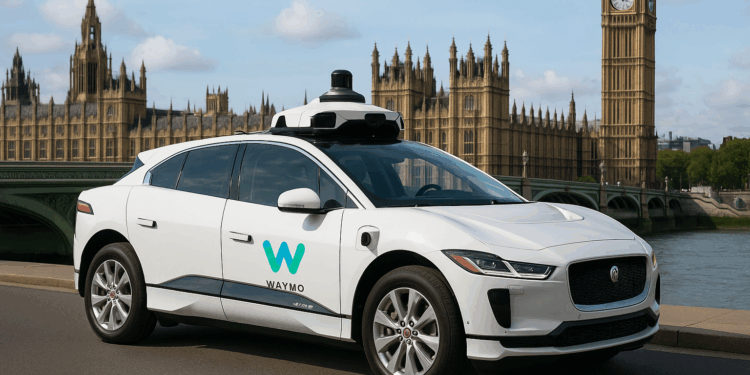Story Highlight
– Waymo plans fully autonomous ride-hailing service in London.
– Collaboration with Moove for operational groundwork and permissions.
– Waymo Driver has 100 million autonomous miles in US.
– UK government supports Waymo’s service for transport improvements.
– Aims to enhance safety and accessibility for Londoners.
Full Story
Waymo, the prominent American company specialising in autonomous driving technology, has announced plans to introduce a fully driverless ride-hailing service in London by next year. This innovative initiative aims to integrate seamlessly with the capital’s comprehensive transport network, which includes buses, trains, bicycles, and pedestrian paths.
In the upcoming months, Waymo intends to collaborate closely with its fleet operations partner, Moove, to establish the foundation of this new service. The company is also committed to engaging with local and national government officials to obtain the necessary regulatory approvals for its operation in the UK.
Waymo’s autonomous driving system, known as the Waymo Driver, has already demonstrated its capabilities in the United States, where it has successfully navigated over 100 million miles on public roads without human intervention and has facilitated more than 10 million paid rides.
In a statement regarding the venture, Tekedra Mawakana, Waymo’s co-CEO, expressed enthusiasm about extending the company’s service to Londoners. Mawakana stated, “We’re thrilled to bring the reliability, safety and magic of Waymo to Londoners. Waymo is making roads safer and transportation more accessible where we operate. We’ve demonstrated how to responsibly scale fully autonomous ride-hailing, and we can’t wait to expand the benefits of our technology to the United Kingdom.”
Waymo’s connection to the UK is significant, with London and Oxford being home to its initial international engineering centres. These hubs focus on advancing closed-loop simulation techniques, described as a gold standard in the development of fully autonomous driving technology.
Additionally, Waymo has formed a partnership with Jaguar Land Rover, the British automotive manufacturer. The collaboration has led to the deployment of all-electric I-PACE vehicles equipped with the Waymo Driver technology. These vehicles are currently facilitating hundreds of thousands of fully autonomous rides each week in the US and are also operational in Tokyo.
The news of Waymo’s impending arrival has been met with optimism from the UK Government. Heidi Alexander, the secretary of state for transport, expressed her delight at the company’s plans, stating, “I’m delighted that Waymo intends to bring their services to London next year, under our proposed piloting scheme. Boosting the AV sector will increase accessible transport options alongside bringing jobs, investment, and opportunities to the UK. Cutting-edge investment like this will help us deliver our mission to be world-leaders in new technology and spearhead national renewal that delivers real change in our communities.”
Waymo has indicated that its presence in London could significantly contribute to the city’s transportation objectives, especially in terms of reducing the number of road traffic incidents resulting in fatalities or serious injuries. According to data obtained from Waymo’s operations, its autonomous vehicles are involved in five times fewer injury-causing collisions overall, and twelve times fewer instances involving pedestrians compared to traditional human drivers.
The company believes its service will offer an additional mode of transportation that promotes safety and accessibility for Londoners. This initiative is particularly pertinent for individuals who currently lack adequate mobility options, ensuring they can navigate the city with greater independence.
Robin Spinks, head of inclusive design at the Royal National Institute of Blind People (RNIB), acknowledged the potential impact of Waymo’s introduction in the UK. He remarked, “The planned introduction of Waymo in the UK represents the potential for the dawn of a new era in independent mobility options for blind and partially sighted people. As someone who’s been severely sight impaired since birth, I’ve long hoped for the day when technology can safely enable spontaneous autonomous travel. Autonomous vehicle systems should be accessible to everyone and we’re working with the community and our industry partners to ensure that the rollout of this technology prioritises the safety and diverse needs of riders and pedestrians.”
Support for Waymo’s initiatives is echoed by Road Safety GB, with Executive Director James Gibson commenting on the safety benefits of autonomous vehicles. “Autonomous vehicles, such as Waymo, hold the potential to significantly improve road safety because, quite simply, the human driver is removed,” he stated. Gibson highlighted that data from Waymo’s autonomous journeys shows considerably safer performance compared to human drivers, affirming that gradual and responsible deployment of autonomous vehicles represents a positive step forward for society. He concluded by calling for collective acceptance of this technology, which could align with the broader goals for road safety envisioned by the public and professionals alike.
Key Takeaways
– Waymo plans to launch a fully autonomous ride-hailing service in London next year, eliminating the need for human drivers.
– Collaboration with Moove and local authorities is underway to establish operational groundwork.
– The service aims to enhance London’s transport ecosystem and promote road safety, having proven safer than human drivers in the U.S.
– UK Government expresses support, highlighting potential job creation and investment benefits.
– The initiative is expected to improve mobility options, especially for underserved groups, including the visually impaired, and align with London’s transport safety goals.






















This is a significant step for urban transport but it must not come at the expense of safety. Rigorous local risk assessments, clear maintenance and charging protocols, and robust incident reporting arrangements will be essential before vehicles operate on London streets. Operators should work closely with local authorities and emergency services to integrate these vehicles into existing traffic management and pedestrian safety plans. Accessibility claims should be backed by practical measures such as staff training, easy to use interfaces and contingency procedures for passengers who need assistance. Continuous monitoring and transparent public reporting on safety performance will help maintain public trust as the service scales.
This is an important development but it must be matched by robust safety oversight and clear operational protocols. Regulators and operators should ensure comprehensive vehicle validation in London traffic conditions, rigorous cybersecurity measures, and transparent incident reporting. Driver and passenger safety procedures for remote intervention need to be well defined, and accessibility features must be tested with real users, including those with visual impairments. Ongoing monitoring, independent audits and public engagement will be essential to maintain trust as the service scales.
This is a significant development for urban transport. From a safety and operational readiness perspective it will be important that Waymo and partners provide clear evidence of robust risk assessment, comprehensive testing in varied London conditions, and transparent incident reporting. Attention should be paid to interaction with pedestrians, cyclists and mixed traffic at busy junctions, and to how the system will perform in complex weather and roadworks scenarios. Accessible features should be validated with input from representatives of disabled communities. Emergency procedures for disengagements and vehicle faults need to be well rehearsed and communicated to the public. Ongoing oversight and independent auditing will help build public trust as the service scales.